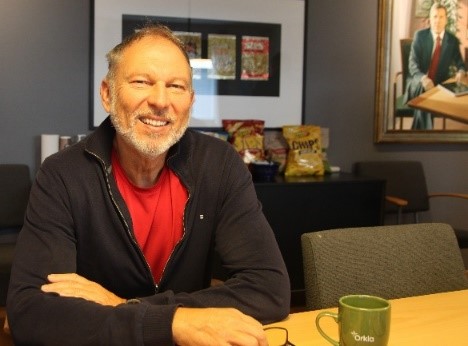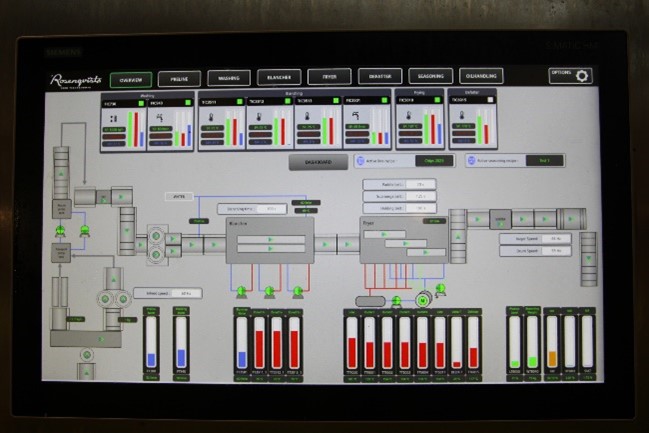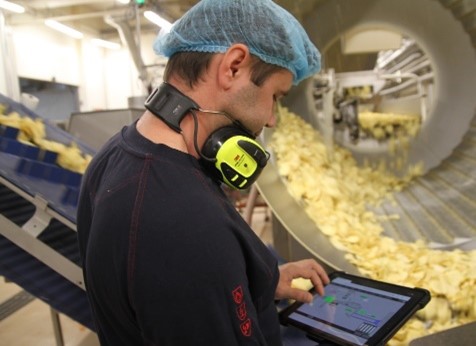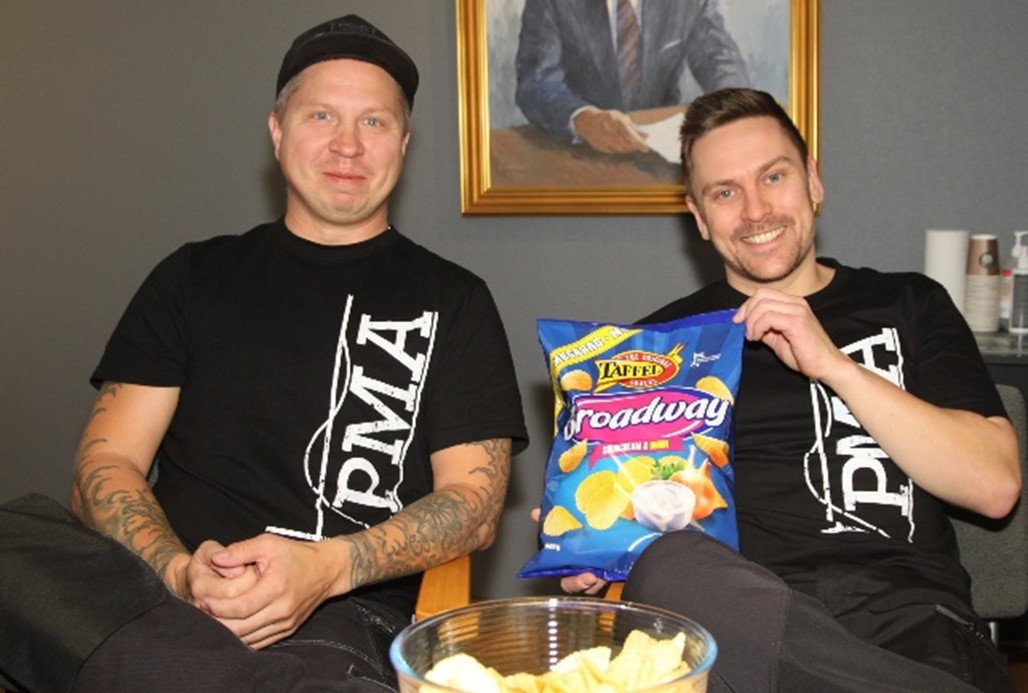18 April, 2024
Reduce resource waste with new HMI platform
Using a new, standardized HMI platform with Simatic WinCC Unified brings Orkla’s factory in Åland one step closer to Industry 4.0. Automation integrator PMA joined forces with machine builder Rosenqvists Food Technologies to significantly raise standards at Orkla’s factory in Åland, Finland.
THE CHALLENGE | At The Haraldsby factory in Åland, Orkla had a lot of systems using old equipment. Orkla needed to ensure uptime and operation in order to achieve efficient, safe and sustainable production.
THE SOLUTION | Working with Rosenqvists Food Technologies, PMA has raised the standard with a new, standardised HMI platform using Siemens panels and visualisation software within the Simatic WinCC Unified System.
THE RESULT | Orkla is able to produce the same quantities more efficiently and monitor KPIs to enable a faster response to deviations. User-friendliness is improved, resource consumption is optimised, waste is reduced, quality is improved and safety standards are raised throughout the process feeder.
Orkla’s factory in Åland has always been ambitious. “We like to be at the cutting edge. To do so, we have go out on a limb and test new technology,” according to Christer Söderström, factory manager at Orkla.

“This is how you keep a step ahead of the competition,” says Thomas Nilsson, operating manager at Rosenqvists Food Technologies, who have worked with Orkla for many years and specialise in building machines and process lines for snacks and frozen potato products.

DATA COLLECTION REDUCES ENERGY USE AND MEDIA CONSUMPTION
Each year, 38,000 tonnes of potatoes are used to produce 15,000 tonnes of finished potato products such as crisps, fries and pyttipanna hash at the Haraldsby factory. The factory has now taken a step towards more efficient, safer and more sustainable production.
“Enhanced data collection capabilities enable Orkla to reduce its energy use and media consumption, in the form of process water for example, and give operators a better overview of what is happening in the process. Orkla gets better quality and a reduction in resource losses, resulting in a greener footprint,” says Niklas Möllerstedt, account manager for Orkla at Rosenqvists.
Using Siemens technology, the factory is taking a big step towards Industry 4.0.
“Soon, all operatives will be going around with tablets and smartphones.”

THE NEED TO UPGRADE
Having adopted automated production lines back in the 1990s, Rosenqvists has been gradually advancing to the cutting edge of technology, working closely with PMA since 2009 on advancing control modules, electrical documentation, software and assistance with commissioning. In 2013, PMA introduced Simatic S7-300 control systems with Simatic HMI MP panels at Orkla, and in 2015 PMA introduced the TIA Portal automation platform as standard at Rosenqvists, as the successor to the Simatic Step 7 Classic programming tool.
“The S7-300 systems were programmed in Simatic Step 7 and were not compatible with newer systems, holding back development of Orkla’s process feeder. It was time to modernise the feeder to future-proof availability of spare parts and to create an overall boost,” says Calle Lundin, one of four partners, and process and food industry operations manager and sales manager at PMA.

RETROFIT FOR BETTER VISUALISATION AND LESS RESOURCE WASTE
What began purely as a replacement project grew into a major development project built for the future.
“Initially, we were only going to replace the hardware, but we switched to building a brand-new HMI platform with standardised technology by Siemens,” Calle Lundin explains.
Orkla was keen to create better visualisation and user interfaces to be able to monitor KPIs to enable a faster response to deviations by streamlining and facilitating the work for operatives and management alike with a view to achieving more sustainable and reliable production.

“This is in line with the digital transformation journey we want to and must embrace to get better control of our process feeders, so we can reduce waste and consumption of electricity, water, steam and oil along the feeders,” says Christer Söderström.
“We want to know where we stand at the moment in order to be able to make improvements and respond quickly to what is happening right now. For this, we needed an intuitive interface. Everything needs to be as simple as possible so you know immediately what to do. Push-notifications and information work better than having the operatives themselves retrieve the information,” Christer Söderström continues.
“How are we doing right now? Are we on target? We want to know in detail where we are now – in other words, what we need to respond to. Visualisation and the user interface become extremely important. If the values diverge, notifications are sent to our tablets or smart watches and we can respond immediately instead of having the quality department perform spot checks once every half hour,” says Sam Landström, maintenance manager at Orkla.
“Instead of belatedly noticing a trend emerging, you can respond immediately. What is so good about Siemens is that it is so easy to connect with other systems in the factory to give you a comprehensive overview,” says Calle Lundin.
NEW HMI PLATFORM TO STREAMLINE OPERATIONS
In 2021, work began to phase out Orkla’s Simatic S7-300 control systems using Simatic ET 200S-Profibus nodes and the old MP panels, to switch to Simatic S7-1500 control systems with built-in security, Simatic ET 200SP nodes on Profinet and new Simatic WinCC Unified panels and runtime. PMA developed the brand-new, scalable HMI platform that will become the new standard for all Rosenqvists’ machines in future projects. Tests were performed and evaluated in a lab environment and on small-scale projects to obtain the previously used functionalities, whereupon the system was implemented live at full scale to see how far it could be developed.
“The standard we have developed for Rosenqvists can then be customised as needed. The new standard reduces Rosenqvists’ development time in all projects, and we all know that time is money,” says Calle Lundin.
“Rosenqvists has the Siemens Simatic S7-1500 control system as standard for 99 per cent of all its equipment shipped around the world. Orkla’s new control system in Godby is truly cutting edge, with a clean interface and massive development potential for add-on systems such as the Simatic Notifier app,” according to Calle Lundin.

MACHINE AND CYBER SECURITY
HTML5 and SVG support for the Simatic WinCC Unified panels opens up many new possibilities for the TIA Portal automation platform.
“Thanks to the open-source interfaces, we can easily adapt the WinCC Unified system to all our needs,” says Victor Grigore, automation engineer at Orkla.

“We chose a fail-safe control system so that before long we will be able to segregate emergency stop zones that are currently on a conventional emergency stop switch, to more easily integrate emergency stop communication with third-party machines on the process feeder, thus raising safety standards throughout the feeder,” says Calle Lundin.
New Profinet cables were added to replace the existing Profibus cables and Simatic ET 200SP nodes were distributed in the plant: a large network arranged as both star and drop networks was deployed to control nodes, servos, wave devices, third-party machines and communication with the other Siemens PLC units in the water management plant and elsewhere. Strong emphasis was placed on deploying new flow meters for process water, steam and compressed air for data collection and energy optimisation without compromising on the quality of the finished product.
All third-party machines are integrated into the platform, which has encrypted communication throughout.
“With Siemens, IT security is a given. As long as you run updates as you should, you know it’s secure,” says Calle Lundin.
“What’s so reassuring about the Siemens platform and their equipment is that you can see their development department is actively working to ensure the safe, error-free operation of their equipment and, not least, the vast Siemens community that provides them with feedback,” says Victor Grigore.
SIMPLIFICATION THROUGH OBJECT-BASED PROGRAMMING
Web clients on tablets communicate with the web server so that operatives and maintenance personnel can take tablets out onto the factory floor to run checks and perform troubleshooting. Instead of conventional PLC programming, the entire control system is now object-based, as the entire visualisation is linked with icons in the form of faceplates with associated pop-ups where a data tag tells the visualisation what kind of object it is and what it should look like.
“Instead of creating 30 different icons, we have created a default visualisation structure that changes automatically. From the PLC code, you control how the symbols should look depending on which blocks you use to build functions,” says Calle Lundin.
PMA has spent about 600 hours creating all the icons, buttons, pop-ups, function blocks etc. to be automatically generated. If the developer adds an object for an engine to the PLC code, icons and pop-ups all automatically change to an engine. If the object then receives an add-on block with a Siemens G120 frequency inverter on Profinet, the icon and pop-up will change accordingly, with associated data collection.
“This object-based way of programming control and visualisation reduces project development time by 30 per cent, while also minimising the risk of errors to virtually zero per cent, speeding up the start-up time and thus reducing downtime for the customer. And this will become standard on all Rosenqvists’ machine feeders sold around the world,” says Calle Lundin.
“What is more, we have taken advantage of the strengths of WinCC Unified with SVG images, doing away with scaling for 12–22” panels, so it is literally one size fits all. Now, with TIA Portal V18, we feel that WinCC Unified can be fully replaced with WinCC Advanced. Unified is really powerful, with astonishingly good trend capacity!
“Besides the advantages of HTML5 and the IoT, as developers we also appreciate the ability to customise and reuse objects and libraries in a way that did not previously exist. At the same time, we are able to offer our customers a more advanced solution that is more like a SCADA system than a simple HMI application, but at a lower cost,” says Dennis Lesonen, a programmer at PMA.
“The step of being able to deliver the IoT at a reasonable price has truly been taken with TIA Portal V18 and Unified. Achieving Industry 4.0 has become much easier now,” says Calle Lundin.
THE IoT JOURNEY CONTINUES WITH INDUSTRIAL EDGE
Everything has been connected to the factory’s MES system and is integrated into the factory network that manages all Orkla’s factories in northern Europe. This is where data collection of all flows and losses takes place in the true spirit of Industry 4.0.
“The thing about the IoT is that you should be able to collect information from multiple components and get push notifications about what you need to know, here and now. There are also opportunities to collect historical data. The more you can measure, the greater the product traceability and scope for influencing your carbon footprint,” says Christer Söderström.
“This development work never ends. Industrial Edge will be the next step; there will be more and more to follow,” says Calle Lundin, noting:
“Siemens is not the cheapest but has the most useful technology that can communicate best and is the most highly integrated with other systems. If it pays, you can invest in development too.”
Thomas Nilsson agrees:
“Cheap can be expensive in the long run. When you invest in a Siemens system, you know it is going to serve you for a long time. When the system gets old, it can be migrated to a more modern one and products that are being phased out can stay for another ten years. That is brilliant.”

FAIL-SAFE CONTROL SYSTEM | Simatic S7-1516F
HMI | panels: Simatic WinCC Unified Panels (MTP2200, MTP1200); visualisation software: Simatic WinCC Unified (WinCC Runtime Advanced/Professional)
BUS COMMUNICATION | Profinet
DISTRIBUTED I/O | Simatic ET 200SP
NETWORK COMMUNICATION | network switches: Scalance XB005
PROCESS INSTRUMENTS | flow meters: Sitrans FM MAG, Sitrans FC330 Coriolis Mass Flow Meter System; control valves: Sipart PS2; weighing module: Siwarex
FREQUENCY INVERTER | Sinamics G120
POWER SUPPLY | Sitop UPS1100, Sitop PSU305
LOW VOLTAGE PRODUCTS | starters: Sirius; power distribution: Sentron



